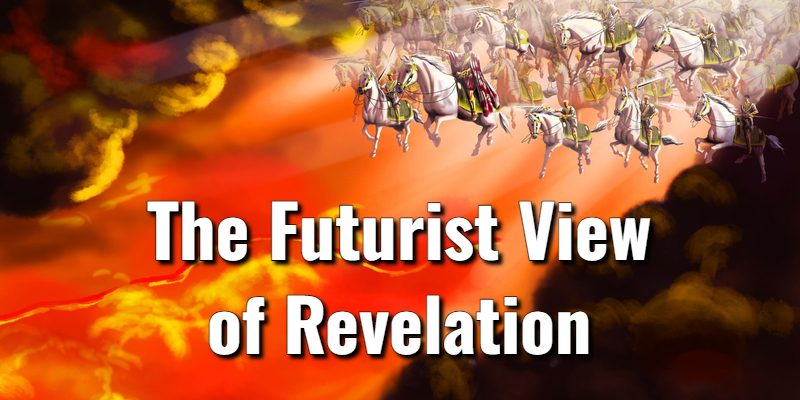The Futurist view of the Book of Revelation is an interpretive approach that sees most of the prophecies in the book as pertaining to future events, particularly those associated with the end times. Proponents of this view believe that the book offers a roadmap to understand the sequence of events leading to the second coming of the Lord Jesus Christ, the great tribulation, and the final judgment. Many Futurists anticipate the rise of an Antichrist figure who will play a central role in the end-time events, opposing Christ and deceiving the world. They view the great tribulation as a future period of intense suffering and turmoil preceding the return of Christ. There are variations within the Futurist perspective, with some adherents advocating for a pre-tribulation rapture (the belief that believers will be taken to be with Christ before the great tribulation), a mid-tribulation rapture (believers are taken during the middle of the tribulation), or a post-tribulation rapture (believers are taken after the tribulation). Representing one of the most common of the different views, Christians who subscribe to the Futurist view of Revelation often cite the below Bible verses.
The Futurist View of Revelation
Futurist View of Revelation: Key Bible Verses
Key Bible verses:
- Revelation 1:19: “Write the things which thou hast seen, and the things which are, and the things which shall be hereafter.”
Futurists often highlight the phrase “the things which shall be hereafter” as indicating that a significant portion of the book pertains to future events.
- Revelation 4:1: “After this I looked, and, behold, a door was opened in heaven: and the first voice which I heard was as it were of a trumpet talking with me; which said, Come up hither, and I will shew thee things which must be hereafter.”
This verse is seen as a pivotal moment when John is transported to witness future events, reinforcing the Futurist interpretation.
- Revelation 6:1-2: “And I saw when the Lamb opened one of the seals, and I heard, as it were the noise of thunder, one of the four beasts saying, Come and see. And I saw, and behold a white horse: and he that sat on him had a bow; and a crown was given unto him: and he went forth conquering, and to conquer.”
The opening of the first seal with a rider on a white horse is often interpreted as a future event, symbolizing the rise of a powerful leader or ruler during the end times.
- Revelation 19:11-16: “And I saw heaven opened, and behold a white horse; and he that sat upon him was called Faithful and True, and in righteousness he doth judge and make war. His eyes were as a flame of fire, and on his head were many crowns; and he had a name written, that no man knew, but he himself. And he was clothed with a vesture dipped in blood: and his name is called The Word of God. And the armies which were in heaven followed him upon white horses, clothed in fine linen, white and clean. And out of his mouth goeth a sharp sword, that with it he should smite the nations: and he shall rule them with a rod of iron: and he treadeth the winepress of the fierceness and wrath of Almighty God. And he hath on his vesture and on his thigh a name written, KING OF KINGS, AND LORD OF LORDS.”
The description of Jesus Christ returning on a white horse to conquer the nations is a central focus of the Futurist viewpoint, representing the anticipated return of Christ in glory and judgment.
- Revelation 20:1-10: “And I saw an angel come down from heaven, having the key of the bottomless pit and a great chain in his hand. And he laid hold on the dragon, that old serpent, which is the Devil, and Satan, and bound him a thousand years, And cast him into the bottomless pit, and shut him up, and set a seal upon him, that he should deceive the nations no more, till the thousand years should be fulfilled: and after that he must be loosed a little season. And I saw thrones, and they sat upon them, and judgment was given unto them: and I saw the souls of them that were beheaded for the witness of Jesus, and for the word of God, and which had not worshipped the beast, neither his image, neither had received his mark upon their foreheads, or in their hands; and they lived and reigned with Christ a thousand years. But the rest of the dead lived not again until the thousand years were finished. This is the first resurrection. Blessed and holy is he that hath part in the first resurrection: on such the second death hath no power, but they shall be priests of God and of Christ, and shall reign with him a thousand years. And when the thousand years are expired, Satan shall be loosed out of his prison, And shall go out to deceive the nations which are in the four quarters of the earth, Gog and MaGog, to gather them together to battle: the number of whom is as the sand of the sea. And they went up on the breadth of the earth, and compassed the camp of the saints about, and the beloved city: and fire came down from God out of heaven, and devoured them. And the devil that deceived them was cast into the lake of fire and brimstone, where the beast and the false prophet are, and shall be tormented day and night for ever and ever.”
The events surrounding the thousand-year reign of Christ, the release of Satan, and the final judgment are considered by Futurists as yet-to-occur events that will unfold in the future.
Lord's Library is a Christian resource hub. Our editors use a variety of internet research methods like search engines, audio and video, AI, consultations with ministry leaders in the field, and more. Lord's Library should never be a substitute for reading your Bible daily as the Scriptures are to be our final authority on all matters. Lord's Library participates in affiliate programs. We may make a small commission from products purchased through this resource.
- What Does the Bible Say About Achievements? With Key Scriptures - April 11, 2025
- What does the Bible Say About Abortion? With Key Scriptures - April 11, 2025
- Prosperity Gospel Meaning in the Scriptures: Is it Biblical? - April 7, 2025













